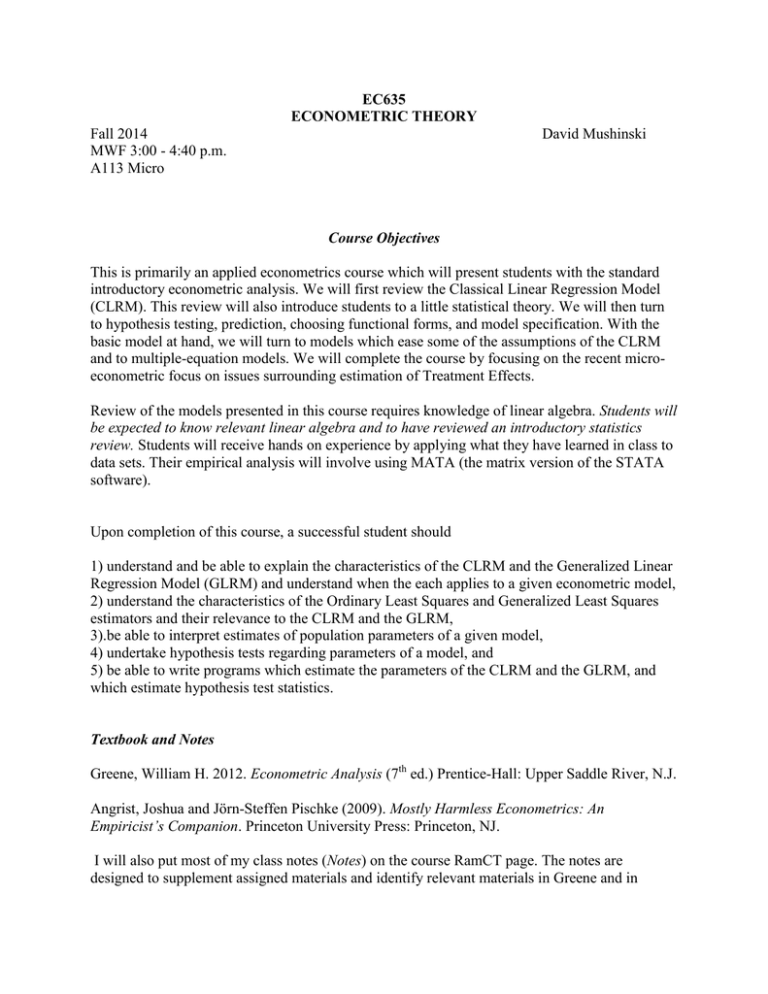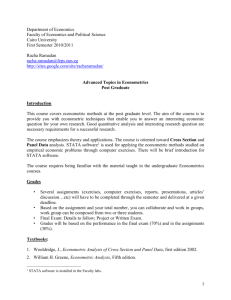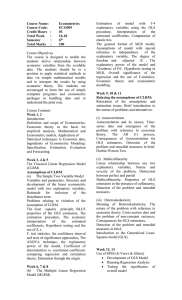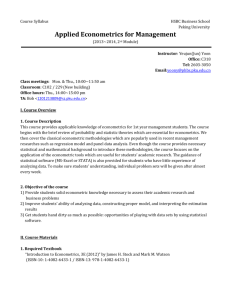EC635 ECONOMETRIC THEORY Fall 2014
advertisement

EC635 ECONOMETRIC THEORY Fall 2014 MWF 3:00 - 4:40 p.m. A113 Micro David Mushinski Course Objectives This is primarily an applied econometrics course which will present students with the standard introductory econometric analysis. We will first review the Classical Linear Regression Model (CLRM). This review will also introduce students to a little statistical theory. We will then turn to hypothesis testing, prediction, choosing functional forms, and model specification. With the basic model at hand, we will turn to models which ease some of the assumptions of the CLRM and to multiple-equation models. We will complete the course by focusing on the recent microeconometric focus on issues surrounding estimation of Treatment Effects. Review of the models presented in this course requires knowledge of linear algebra. Students will be expected to know relevant linear algebra and to have reviewed an introductory statistics review. Students will receive hands on experience by applying what they have learned in class to data sets. Their empirical analysis will involve using MATA (the matrix version of the STATA software). Upon completion of this course, a successful student should 1) understand and be able to explain the characteristics of the CLRM and the Generalized Linear Regression Model (GLRM) and understand when the each applies to a given econometric model, 2) understand the characteristics of the Ordinary Least Squares and Generalized Least Squares estimators and their relevance to the CLRM and the GLRM, 3).be able to interpret estimates of population parameters of a given model, 4) undertake hypothesis tests regarding parameters of a model, and 5) be able to write programs which estimate the parameters of the CLRM and the GLRM, and which estimate hypothesis test statistics. Textbook and Notes Greene, William H. 2012. Econometric Analysis (7th ed.) Prentice-Hall: Upper Saddle River, N.J. Angrist, Joshua and Jörn-Steffen Pischke (2009). Mostly Harmless Econometrics: An Empiricist’s Companion. Princeton University Press: Princeton, NJ. I will also put most of my class notes (Notes) on the course RamCT page. The notes are designed to supplement assigned materials and identify relevant materials in Greene and in Angrist. The notes have not been proofread. Use of the notes is optional. I make my notes available to help the students who will benefit from them. You do not have to use the notes if they do not help you learn the materials. Contact Hours: Each week students will be expected to spend the following time on this course Activity Contact Hours per Week Attend Class 3 Review Assigned Readings 5 Review Class Notes, problem sets, and prepare for tests 6 Total 14 Grading There will be three examinations: two midterms and a final. The first exam will be administered after we complete a review of statistics (approximately at the end of week 4), the second exam will be administered after our review of the Classical Linear Regression Model (at the end of week 10), and the final exam will cover our review of the Generalized Classical Linear Regression Model. There will be approximately four problem sets. The problem sets will be worth the remaining 25% of the course grade. Each problem set will be worth the same percentage of the course grade. That percentage will depend on the number of problem sets assigned. Accommodations for Students with Disabilities: University policy regarding students with disabilities is defined at http://rds.colostate.edu./ Office Hours: MW 1:00 - 2:00 and by appointment. Academic Integrity: The University takes academic integrity seriously. At a minimum, academic integrity means that no one will use another’s work as their own. Of course, academic integrity means more than just avoiding plagiarism. It also involves doing your own reading and studying. It includes regular class attendance, careful consideration of all class materials, and engagement with the class and your fellow students. Academic integrity lies at the core of our common goal: to create an intellectually honest and rigorous community. Because academic integrity, and the personal and social integrity of which academic integrity is an integral part, is so central to our mission as students, teachers, scholars, and citizens, we will ask to you sign the CSU Honor Pledge as part of completing all of our major assignments. While you will not be required to sign the honor pledge, we will ask each of you to write and sign the following statement on your papers and exams: “I have not given, received, or used any unauthorized assistance.” Course Outline Topic Reading (Chapter references are to Greene) I. Introduction Ch. 1 II. Statistics Review Primarily Notes. (A) Probability and Distribution Theory App. B, §§ 1-4, 6-8. (B) Statistical Inference App. C, §§ 1-5, App. D. III. Matrix Algebra Review (Not covered in class. Students Review on their own) Appendix A & Notes IV. Classical Regression Model Chs. 2-4 & relevant parts of Angrist Ch. 3. V. Hypothesis Testing and Practical Issues Which Arise In Model Estimation (A) Hypothesis Tests and Model Selection Ch. 5 (B) Functional Form and Structural Change Ch. 6 (C) Endogeneity and Instrumental Variable Estimation Ch. 8 & relevant parts of Angrist Ch. 4. VI. Generalized Classical Regression Models (A) General Principles Ch. 10 §§ 1, 2, & 3. (B) Heteroskedasticity Ch. 10 §§ 4 - 8. (C) Autocorrelation Ch. 20 §§ 1-3, 5, 7- 9. (D) Spatial Autocorrelation (time permitting) pp. 389 - 394 & Notes V. Systems of Equations (A) Seemingly Unrelated Regressions (time permitting) Ch. 10 §§ 1 & 2. (B) Simultaneous Equations Models Ch.10 § 6.





